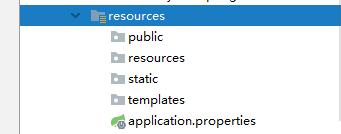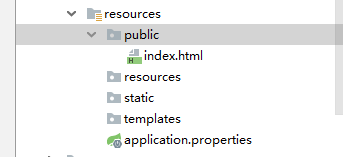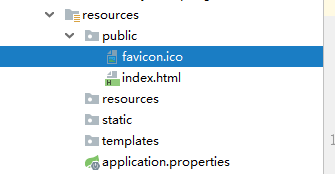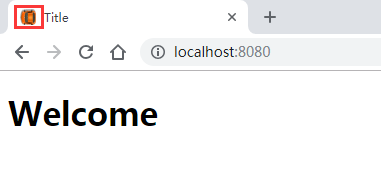1.首先创建一个Spring Boot应用的web工程 , 具体步骤参照 : IEDA快速创建Spring-Boot应用
2.Spring Boot对静态资源的映射规则:
Ctrl+N搜索 : WebMvcAutoConfiguration

再Ctrl+F搜索方法 : addResourceHandlers , 可以看到下面
public void addResourceHandlers(ResourceHandlerRegistry registry) {
if (!this.resourceProperties.isAddMappings()) {
logger.debug("Default resource handling disabled");
} else {
Integer cachePeriod = this.resourceProperties.getCachePeriod();
if (!registry.hasMappingForPattern("/webjars/**")) {
this.customizeResourceHandlerRegistration(registry.addResourceHandler(new String[]{"/webjars/**"}).addResourceLocations(new String[]{"classpath:/META-INF/resources/webjars/"}).setCachePeriod(cachePeriod));
}
String staticPathPattern = this.mvcProperties.getStaticPathPattern();
if (!registry.hasMappingForPattern(staticPathPattern)) {
this.customizeResourceHandlerRegistration(registry.addResourceHandler(new String[]{staticPathPattern}).addResourceLocations(this.resourceProperties.getStaticLocations()).setCachePeriod(cachePeriod));
}
}
}按住Ctrl键点击 resourceProperties


@ConfigurationProperties(
prefix = "spring.resources",
ignoreUnknownFields = false
)
public class ResourceProperties implements ResourceLoaderAware, InitializingBean {
//可以设置和静态资源有关的参数,缓存时间等
.....
}(1)所有/webjars/** , 都去 classpath:/META-INF/resources/webjars/ 找资源
webjars : 以jar包的形式引入静态资源
<!--引入jQuery-webjar-->
<dependency>
<groupId>org.webjars.bower</groupId>
<artifactId>jquery</artifactId>
<version>3.3.1</version>
</dependency> 
访问的时候只需要写webjars下面资源的路径(各版本之间路径略有差异) : localhost:8080/webjars/jquery/3.3.1/dist/jquery.js

(2)"/**"访问当前项目的任何资源 , (静态资源的文件夹)
"classpath:/META-INF/resources/",
"classpath:/resources/",
"classpath:/static/",
"classpath:/public/",
"/" : 当前项目的根路径
按住Ctrl键点击:



public class ResourceProperties implements ResourceLoaderAware, InitializingBean {
private static final String[] SERVLET_RESOURCE_LOCATIONS = new String[]{"/"};
//在以下文件夹中加载资源
private static final String[] CLASSPATH_RESOURCE_LOCATIONS = new String[]{"classpath:/META-INF/resources/", "classpath:/resources/", "classpath:/static/", "classpath:/public/"};
private static final String[] RESOURCE_LOCATIONS;
private String[] staticLocations;
private Integer cachePeriod;
private boolean addMappings;
private final ResourceProperties.Chain chain;
private ResourceLoader resourceLoader;
...........
}以这三个静态资源文件夹为例 : localhost:8080/xxx ===去静态资源文件夹里面找xxx

(3)欢迎页 : 静态资源文件夹下的所有index.html页面 ; 被"/**"映射 ;
localhost:8080/ 找index页面
//配置欢迎页映射
@Bean
public WebMvcAutoConfiguration.WelcomePageHandlerMapping welcomePageHandlerMapping(ResourceProperties resourceProperties) {
return new WebMvcAutoConfiguration.WelcomePageHandlerMapping(resourceProperties.getWelcomePage(), this.mvcProperties.getStaticPathPattern());
}↓↓
private String[] getStaticWelcomePageLocations() {
String[] result = new String[this.staticLocations.length];
for(int i = 0; i < result.length; ++i) {
String location = this.staticLocations[i];
if (!location.endsWith("/")) {
location = location + "/";
}
result[i] = location + "index.html";
}
return result;
}在publi文件夹下创建一个index.html文件 :

<!DOCTYPE html>
<html lang="en">
<head>
<meta charset="UTF-8">
<title>Title</title>
</head>
<body>
<h1>Welcome</h1>
</body>
</html>运行项目后访问 : localhost:8080/

访问成功!
(4)所有的 **/favicon.ico 都是在静态资源文件下找 ;
配置喜欢的图标:
//配置喜欢的图标
@Configuration
@ConditionalOnProperty(
value = {"spring.mvc.favicon.enabled"},
matchIfMissing = true
)
public static class FaviconConfiguration {
private final ResourceProperties resourceProperties;
public FaviconConfiguration(ResourceProperties resourceProperties) {
this.resourceProperties = resourceProperties;
}
@Bean
public SimpleUrlHandlerMapping faviconHandlerMapping() {
SimpleUrlHandlerMapping mapping = new SimpleUrlHandlerMapping();
mapping.setOrder(-2147483647);
mapping.setUrlMap(Collections.singletonMap("**/favicon.ico", this.faviconRequestHandler()));
return mapping;
}
@Bean
public ResourceHttpRequestHandler faviconRequestHandler() {
ResourceHttpRequestHandler requestHandler = new ResourceHttpRequestHandler();
requestHandler.setLocations(this.resourceProperties.getFaviconLocations());
return requestHandler;
}
}去网站制作一个喜欢的图标 , 放在public文件夹里 :

然后重新启动一下项目访问 : localhost:8080

图标就配置成功了!
也可以在配置文件中修改静态资源文件夹路径:
多个路径用 "," 隔开
定义静态资源文件夹后 , 知识点(2)的路径就不生效了
